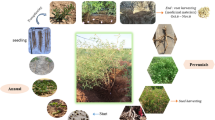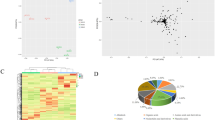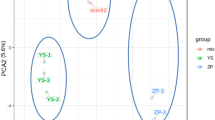Abstract
Ephedra sinica, a well-known Chinese medicinal plant, is characterized as having the opposite medicinal effect among its root and stem. However, there is a lack of understanding to differentiate the active components present in the root and stem of E. sinica, as well as the molecular mechanisms underlying the formation of the differential compounds, which has significantly hampered the further development and utilization of E. sinica resource. In this study, forty-five differential metabolic markers are affiliated to alkaloids, flavonoids, terpenoids, and organic acids between root and stem of E. sinica, and sixty genes of key enzymes are involved in their biosynthesis distributed in metabolic pathway branches such as phenylalanine metabolism, flavonoid biosynthesis and phenylpropane biosynthesis, based on combination non-targeted metabolome with transcriptome technologies. The finding revealed that the expression activity changes of these enzyme genes had a direct impact on the distinction of differential metabolic markers in the root and stem of E. sinica. This study will help to understand the molecular mechanism of the differentiation and biosynthesis of the primary active metabolites in the root and stem of E. sinica, providing a theoretical foundation for its quality control and promotion in cultivation.






Similar content being viewed by others
Data Availability
All data generated during this study have been incorporated in this article.
References
Zhang, Q., Xue, X. Z., Miao, S. M., et al. (2020). Differential relationship of fungal endophytic communities and metabolic profiling in the stems and roots of Ephedra sinica based on metagenomics and metabolomics[J]. Symbiosis, 81, 115–125.
Miao, S. M., Zhang, Q., Bi, X. B., et al. (2020). A review of the phytochemistry and pharmacological activities of Ephedra herb[J]. Chinese Journal of Natural Medicines, 18(5), 321–344.
Zhang, B. M., Wang, Z. B., Xin, P., et al. (2018). Phytochemistry and pharmacology of genus Ephedra[J]. Chinese Journal of Natural Medicines, 16(11), 811–828.
Lv, Y. N., Wang, S. S., Liang, P. D., et al. (2021). Screening and evaluation of anti-SARS-CoV-2 components from Ephedra sinica by ACE2/CMC-HPLC-IT-TOF-MS approach[J]. Analytical and Bioanalytical Chemistry, 413(11), 2995–3004.
Anand, A., Komati, A., Katragunta, K., et al. (2021). Tiwari, Phytometabolomic analysis of boiled rhizome of Nymphaea nouchali (Burm. f.) using UPLC-Q-TOF-MS(E), LC-QqQ-MS & GC-MS and evaluation of antihyperglycemic and antioxidant activities[J]. Food Chemistry, 342, 128313.
Stickels, R. R., Murray, E., Kumar, P., et al. (2021). Highly sensitive spatial transcriptomics at near-cellular resolution with Slide-seqV2[J]. Nature Biotechnology, 39(3), 313–319.
Zhao, H. S., Zhong, L., Sang, X., et al. (2020). PaACL silencing accelerates flower senescence and changes proteome to maintain metabolic homeostasis[J]. Journal of Experimental Botany, 71(16), 4858–4876.
Miao, S. M., Xia, Y., Cui, J. L., et al. (2022). Correlation analysis between differential metabolites and bacterial endophytes of Ephedra sinica in different years[J]. Industrial Crops and Products, 175, 114250.
Mufti, A., Tir, M., Zarei, A., et al. (2022). Phytochemical profiling of Ephedra alata subsp. alenda seeds by high-performance liquid chromatography-electrospray ionization-quadrupole-time-of- flight-mass spectrometry (HPLC-ESI-QTOF-MS), molecular docking, and antioxidant, anti-diabetic, and acetylcholinesterase inhibition[J]. Analytical Letters, 1–17.
Hou, J. Y., Wu, J. R., Xu, D., et al. (2021). Integration of transcriptomics and system pharmacology to reveal the therapeutic mechanism underlying Qingfei Xiaoyan Wan to treat allergic asthma[J]. Journal of Ethnopharmacology, 278, 114302.
Hiyama, H., Ozawa, A., Makino, B., et al. (2021). Stability and reproducibility of ephedra sinica ephedrine alkaloid content and terrestrial stem dry weight[J]. Biological and Pharmaceutical Bulletin, 44(11), 1781–1789.
Cui, J. L., Gong, Y., Vijayakumar, V., et al. (2019). Correlation in chemical metabolome and endophytic mycobiome in Cynomorium songaricum from different desert locations in China[J]. Journal of Agriculture and Food Chemistry, 67(13), 3554–3564.
Cingolani, P. A., Platts, L. L., Wang, M., et al. (2012). A program for annotating and predicting the effects of single nucleotide polymorphisms, SnpEff: SNPs in the genome of Drosophila melanogaster strain w; iso-2; iso-3[J]. Fly, 6(2), 80–92.
Morris, J. S., Groves, R. A., Hagel, J. M., et al. (2018). An N-methyltransferase from Ephedra sinica catalyzing the formation of ephedrine and pseudoephedrine enables microbial phenylalkylamine production[J]. The Journal of Biological Chemistry, 293(35), 13364–13376.
Schmittgen, T. D., & Livak, K. J. (2008). Analyzing real-time PCR data by the comparative CT method[J]. Nature Protocols, 3(6), 1101–1108.
Zhang, L., Cao, Y., & Tong, J. (2019). An alkylpyrazine synthesis mechanism involving l-threonine-3-dehydrogenase describes the production of 2,5-Dimethylpyrazine and 2,3,5-Trimethylpyrazine by Bacillus subtilis[J]. Applied and Environmental Microbiology, 85(24), 1807–1819.
Ding, Z., Fu, L., Tie, W., et al. (2020). Highly dynamic, coordinated, and stage-specific profiles are revealed by a multi-omics integrative analysis during tuberous root development in cassava[J]. Journal of Experimental Botany, 71(22), 7003–7017.
Pimentel, D., Amaro, R., Erban, A., et al. (2021). Transcriptional, hormonal, and metabolic changes in susceptible grape berries under powdery mildew infection[J]. Journal of Experimental Botany, 72(18), 6544–6569.
Sun, X., Li, L., Pei, J., et al. (2020). Metabolome and transcriptome profiling reveals quality variation and underlying regulation of three ecotypes for Cistanche deserticola[J]. Plant Molecular Biology, 102(3), 253–269.
Krizevski, R., Bar, E., Shalit, O., et al. (2010). Composition and stereochemistry of ephedrine alkaloids accumulation in Ephedra sinica Stapf[J]. Phytochemistry, 71(8–9), 895–903.
Mao, J., He, Z., Hao, J., et al. (2019). Identification, expression, and phylogenetic analyses of terpenoid biosynthesis-related genes in secondary xylem of loblolly pine (Pinus taeda L.) based on transcriptome analyses[J]. PeerJ, 7, e6124.
Krizevski, R., Bar, E., Shalit, O., et al. (2012). Benzaldehyde is a precursor of phenylpropylamino alkaloids as revealed by targeted metabolic profiling and comparative biochemical analyses in Ephedra spp.[J]. Phytochemistry, 81, 71–79.
Funding
This work was financially supported by the Basic Research Program of Shanxi Province (20210302123428), Research Project Supported by Shanxi Scholarship Council of China (2020–013), Fund Program for the Scientific Activities of Selected Returned Overseas Professionals in Shanxi Province (20220004) and the National Natural Science Foundation of China (31670328 and 31270383).
Author information
Authors and Affiliations
Contributions
Zhang-Xuan Guo, Xiao-Ke Li, and Shuang-Man Miao performed the experiments and drafted the manuscript. Jin-Long Cui conceived the project and revised the manuscript. Meng-Liang Wang, Jun-Hong Wang, and Muhammad Danial provided technology support and reviewed the manuscript. All the authors approved the final draft.
Corresponding author
Ethics declarations
Ethical Approval
Not applicable.
Consent to Participate
Not applicable.
Consent to Publish
Not applicable.
Competing Interests
The authors declare no competing interests.
Additional information
Publisher's Note
Springer Nature remains neutral with regard to jurisdictional claims in published maps and institutional affiliations.
Supplementary Information
Below is the link to the electronic supplementary material.
Rights and permissions
About this article
Cite this article
Guo, ZX., Li, XK., Cui, JL. et al. Transcriptional Regulatory Mechanism of Differential Metabolite Formation in Root and Stem of Ephedra sinica. Appl Biochem Biotechnol 194, 5506–5521 (2022). https://doi.org/10.1007/s12010-022-04039-8
Accepted:
Published:
Issue Date:
DOI: https://doi.org/10.1007/s12010-022-04039-8




